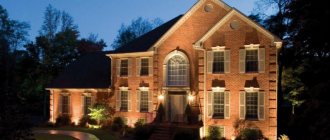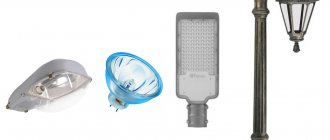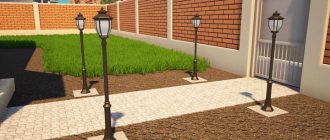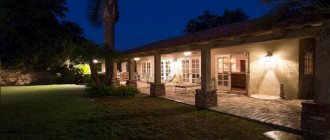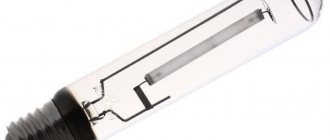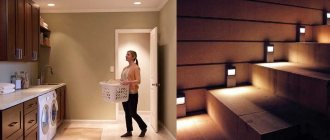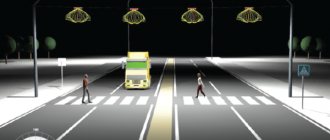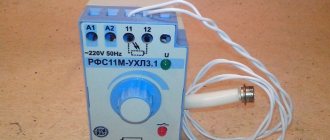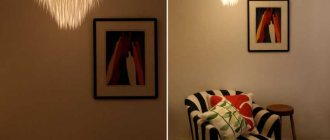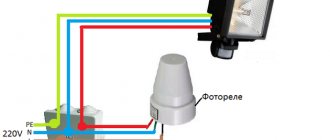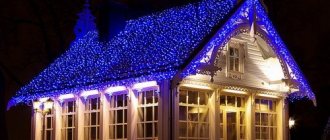External street lighting in the city or in rural areas is the most important point in providing comfortable living conditions for citizens and the movement of drivers. The goals of modern street lighting of roads and other areas are both life safety and improving the aesthetic qualities of a populated area.
There are a number of state norms and rules that govern the lighting system of cities and villages.
What is street lighting like?
In the manufacture of lighting fixtures intended for outdoor use, various materials are used:
- glass,
- plastic,
- forging,
- steel.
Depending on the geographical location, lighting devices can be made in different styles. When there is a specially developed design project, the street lighting can be made in the Baroque style, or high-tech, etc.
High-tech street lighting sources
It is worth understanding that external lighting is divided into main types:
- street lighting,
- roadway lighting,
- external, including decorative,
- pedestrian paths and sidewalks.
There is also a difference in the light sources themselves. They are:
- Fluorescent lamps. They are characterized by a long service life and high luminous efficiency. In addition, they are quite economical, operate silently and have small dimensions.
- Induction lamps. These are electrodeless lamps that operate thanks to a gas cylinder located together with an inductor. Light is produced by plasma.
- Xenon lamps. The light here comes from an electric arc located between two electrodes. Due to the internal content of such lamps, light radiation here can be of a different spectrum.
- Incandescent lamps. They have high power and good heat dissipation, but at the same time they are quite expensive. A separate type of such lamps is halogen, which have a longer service life. This is due to a special additive in the form of a buffer gas.
- Mercury lamps. The basis of the work is the formation of a gas discharge in mercury vapor. When lighting of streets and roads is necessary, general purpose lamps are used. They are economical, therefore, when there is a need to illuminate large areas, their use will be advisable.
- Solar powered lighting. This is a separate type of street lighting device, which is the most economical. The main feature is that there is no need for human participation in the operation of such devices, since there is no connection to the electrical network. They can be used both to illuminate private courtyards and to illuminate city streets. When it is light outside, these lights turn off automatically. And throughout the day they accumulate energy, which they release at night. They are used not only as lanterns, but also as decorative street lighting.
Functional lighting
This is, first of all, safe movement around the site and near it in the dark. If we consider the illumination of a personal plot or backyard from the point of view of comfortable safety, then the illumination of the porch of a house, the entrance to a garage or a parking area and garden paths can be considered a sufficient level.
If we talk about the simplest and least expensive way to illuminate an area that is adjacent to a household, then it is enough to evenly place the lamps along the garden paths. Such lighting can become the basis for garden lighting; for small areas this may be enough.
When designing functional lighting, it is important to remember several key aspects:
- lighting equipment must be durable, all-season, simple and convenient in terms of operation and maintenance;
- It is necessary to maintain harmony between the level of lighting of paths and other landscape objects. A person walking along a path will experience discomfort if it is flooded with too much light. It is better to direct the maximum level of brightness to illuminate accent elements - gazebos, patios, trees or shrubs;
- it is important that the facade of the building remains the most illuminated place on the site; it is psychologically easier for residents of the house and their guests to move from a darker place to an area with bright lighting;
- Another factor of psychological comfort is the fact that even in the darkest time of day the boundaries of the yard or area are visible.
To organize functional lighting, both conventional incandescent lamps and energy-saving, fluorescent lamps with various mounting methods are suitable. The most commonly used are conventional floor lamps . These are lighting fixtures that are mounted vertically and are equipped with frosted glass diffusers, which significantly improve the quality of light from the lamps installed in them. High-tech style floor lamps are becoming increasingly popular, but there are also design projects with retro-style equipment.
Spherical lamps - an organic form of a sphere made of carbonate or polycarbonate, equipped with low-power lamps, can not only create dim lighting, but also decorate the landscape design of any area.
Solar-powered lighting devices are charged during the day (for this purpose they are equipped with special batteries) in order to provide dim lighting of significant areas of the backyard or garden at night. Such devices are mobile and do not require a connection to the power grid; they can be put away for the winter or moved during the warm season to different parts of the garden to illuminate certain objects, constantly changing the appearance and atmosphere of your site at dusk. Because solar-powered devices are equipped with sensors and LEDs that turn on automatically, such lighting can last all night.
In order not to make a mistake when choosing lamps for a personal plot, you can use one simple rule - if the landscape design of the garden is quite diverse, it is dominated by various flower beds, a patio with garden furniture, alpine slides and many other decorative elements, then it is better to opt for lamps of laconic shapes or use hidden backlighting (we will talk about it in more detail later). And in the case of a simple and laconic landscape design that strives for minimalism, you can use retro lamps, fancy shapes, and different shades of lighting.
Recently, built-in lighting systems have been used quite widely not only indoors, but also in garden plots. You can integrate lamps into the bases of steps, alpine slides, fountains, borders and other landscape elements.
What is important to know when purchasing outdoor lighting fixtures:
- Be sure to ask the store for a safety certificate for the device;
- make sure that the certificate contains information about the degree of protection of the purchased product;
- inquire about the warranty period for the external lighting element;
- Pay special attention to the material from which the device is made. The body of the lamp will be actively exposed to sunlight, moisture and other weather conditions. Check whether the inside of the lamp mount is painted; if it rusts, the lamp will have to be thrown away. Lamps made of stainless steel (painted), cast iron and aluminum alloys have proven themselves well in operation.
Basic requirements for street lighting
Any lighting devices are characterized by such indicators as power (W) and luminous flux (Lm). And how effective the operation of a light device is is shown by the ratio of Watts to Lumens. And the higher this indicator, the greater the power of the flashlight. When it comes to LED street lighting, this value is 100Lm/1W.
There are special rules and regulations for outdoor lighting, which are regulated by regulations.
Object type | Class | Average road surface brightness | General uniformity of brightness distribution | Longitudinal uniformity of brightness distribution | Average illumination of the road surface | Uniformity of illumination distribution of the road surface |
| A - highways and city streets | A1 | 2 | 0,4 | 0,7 | 30 | 0,35 |
| A2 | 1,6 | 20 | ||||
| A3 | 1,4 | 20 | ||||
| A4 | 1,2 | 20 | ||||
| B – highways and district streets | B1 | 1,2 | 0,4 | 0,6 | 20 | 0,35 |
| B2 | 1 | 15 | ||||
| B – streets and local roads | IN 1 | 0,8 | 0,4 | 0,5 | 15 | 0,25 |
| AT 2 | 0,6 | 0,4 | 0,5 | 10 | ||
| AT 3 | 0,4 | 0,35 | 0,4 | 6 |
What you need to know about city lighting?
- When it comes to lighting paths for pedestrians and park areas, diffused light is used. This effect is achieved thanks to the specific design of the lampshades. Their power can range from 40 to 120 W.
- Illumination of buildings and structures (for example, house numbers). Special lamps and spotlights are used here.
- Decorative lighting. A variety of lighting devices are used depending on the purpose of the object.
Since street lighting is influenced by a number of climatic factors, specific requirements are imposed on them. For street lighting devices, important indicators are:
- lamp power,
- lifetime,
- luminous efficiency
- device maintenance,
- climatic conditions in a certain area,
- traffic intensity,
- specifics of installation and installation.
Each street lighting device has its own passport, which indicates its parameters. The main indicator is the degree of security of the device. This is, first of all, the level of protection of the device from moisture penetration into it (indicator from 1 to 6) and the level of protection from dust and solid particles entering the lamp (from 1 to 8).
It is worth understanding that the brightness of the flashlight should illuminate the area as much as possible, but at the same time not blind the eyes of road users. When traffic on the road is inconsistent, it is advisable to use reflective lighting. That is, the lights have special sensors that are triggered by movement. They are often used to illuminate sidewalks.
Lighting of roads and sidewalks
Types of street lighting
Lights should be on in almost all socially significant areas of a populated area. There are various classifications of outdoor lighting - according to purpose, types of lighting fixtures, types of supports, control method.
By purpose
Lighting devices are installed on streets, roadways, and pedestrian areas. Lighting can be decorative, used to decorate a populated area.
Streets
The determination of the illumination level is determined by the value of the minimum average brightness of the roadway coverage in the direction of the observer, who is located on the axis of traffic movement. The indicator is measured in candelas/square meter.
To clarify the number and power of lamps, the category of the street is considered, the number of people regularly passing along it, and the significance of the part of the city is assessed.
All streets are divided into the following categories:
- A - highways, expressways, main station and city squares;
- B - highways of regional importance, various areas in residential areas, structures such as theaters, stadiums, large shopping and entertainment centers;
- B - streets of “dormitory” areas, buildings such as business centers, industrial zones;
- G - local streets, small passages;
- D - pedestrian paths, alleys in neighborhoods.
The further the category is located from the beginning of the classification, the lower the required level of illumination will be.
roadway
When installing a lighting system, the intensity of traffic must be taken into account. On a roadway where traffic is high, it is important to ensure complete safety for drivers and other road users. The minimum brightness depends on the number of cars passing on the street in both directions.
Pedestrian paths, sidewalks
Such objects belong to category D, so the level of illumination on them, according to the law, can be minimal - 2 - 4 Lux. Lighting of recreation areas and green spaces has a functional and decorative purpose and ranges from 4 Lx (for alleys on the streets) to 10 Lx (for children's areas).
Decorative lighting
The city necessarily uses different types and forms of decorative (architectural) lighting, especially in new areas. Typically LED or halogen lamps and spotlights are used. They are installed at a certain interval, in a special direction, using techniques of flood light, illumination of individual fragments or background, illumination of the object from the inside.
It is important that the decorative light does not interfere with passing cars or blind drivers, which is always taken into account when designing.
By type of light source
To create lanterns and lamps, different materials are used - metal, glass, plastic. The style of the lighting system may also be different, depending on the main project. There is a division of types of street lighting and light sources.
Incandescent lamps
Conventional light bulbs have good power, but have low heat transfer and are therefore too expensive. The filament is heated in an inert gas so that light is visible. Such lamps are rarely used for street lighting.
Gas discharge lamps
They operate by burning gaseous fuel, which causes an electric discharge. Ethylene, methane or other gases are used as fuel. The luminous efficiency of the lamps is very high, so they are often used for street lighting. The quality of illumination is high, and the lamps are suitable even for decorative purposes. The noise from their operation is unlikely to be important for street lighting, as is the harmful content: the housings of the devices are durable, they cannot even be broken.
Gas discharge lamps are of the following types:
- Mercury. They include mercury vapor, so after the end of their service life they are disposed of in a special way. Mercury lamps require the use of heat-resistant wires, as they become very hot.
- Sodium. A gas discharge appears in sodium vapor. These lamps produce yellow-orange light and are used for outdoor lighting only.
- Metal halide. They have additives from metal halides in mercury vapor, which allow you to adjust the lighting spectrum of the device. The lamp power is high. They are used for illuminating large areas and for decorative lighting of large objects.
Xenon lamps
They have built-in arcs that burn between two electrodes. The latter are made from tungsten. There is an inert gas, mercury or sodium vapor inside. During operation, the gas is enriched with ions and turns into a plasma state with high electrical conductivity.
Fluorescent lamps
They last longer than incandescent lamps and have greater light output. Typically, fluorescent lamps are used for indoor lighting of houses and apartments, but they can also be used for street lighting. Modern lamps have electronic control mechanisms that allow them to work without flickering or noise.
Induction lamps
The light source in induction lamps is plasma, which appears when gas is ionized by high-frequency magnetic fields. To form a magnetic field, a gas cylinder is placed next to the induction coil. The operating time of induction lamps is quite long; they are considered economical and suitable for outdoor use.
Solar powered lighting
The least amount of costs is associated with the use of lighting powered by solar energy. This is an effective way to save money and get beautiful lighting for walls, landscapes, and various architectural compositions.
The lamps do not require a network connection and can be easily moved from place to place. They can work without human control - the brightness increases in the dark and fades during the day. Nowadays, lanterns, pendant lamps, and various lighting decorations are made using solar batteries.
Requirements for street lighting lamps
All types of light sources are characterized by certain indicators. The main ones are power (Watt) and luminous flux (Lumen). The efficiency of a device is measured using the ratio of lumens to watts: the higher the number, the more powerful the lamp. According to the rules, the power of street lamps should be 40 - 125 W, depending on the type of object and the distance between the lamps.
In addition to power, the most important parameters for street lamps are light output, service life, efficiency, and ease of use. Secondary data taken into account:
- installation features;
- possibility of damage;
- negative impact of climate and environment on products.
The degree of protection of the lamp is also important - the shell should not allow moisture and solid particles inside.
By type of support
Depending on the support, street lamps can have different shapes and methods of use.
Lanterns
Mounted on support poles, walls, metal strings of different thicknesses.
Spotlights
There are single-plane and two-plane, they differ in light intensity, type of lamps, and angle of luminous flux.
Lamps
Spherical lamps are round, the light is distributed evenly in different directions. Lampshades are matte, transparent, glossy. Hemispherical lamps are used, the top of which is a reflector, used for horizontal spaces.
Other types of lamps:
- classic (park);
- energy saving;
- bollards;
- indirects (reflected light lamps);
- built-in
By way of managing power supplies
The cable for the lighting system can be overhead or underground. According to the type of regulation, lighting devices can operate autonomously or be controlled by a person. In order to save money, late at night the automation dims the lights and turns them off completely at a given time.
Automatic systems are considered more profitable and convenient, so they are used quite often in modern urban areas. In a number of settlements, all road and city lighting is included in a single centralized system, but in large cities it is always divided into district systems for ease of use.
What types of street lighting devices are there and how to install them?
There is a wide range of outdoor luminaires for urban lighting. Special projects are being developed to equip streets with lighting devices. On the streets they install:
- lanterns (various),
- spotlights,
- lamps.
Lanterns. As for their arrangement, they are mounted on support poles or on the walls of buildings.
Spotlights. They are divided mainly according to the type of lamps and the principle of light distribution. For each specific area, their own projects are drawn up with a subsequent work plan, and the required lamp power is selected.
Lamps. These devices also have their own classification:
- used in parks and recreation areas,
- energy-saving devices for street lighting,
- spherical spherical devices. Their main feature is equal distribution of light in all directions,
- reflected light lamps. Widely used for lighting parks and sports grounds, thanks to the special redistribution of light,
- built-in devices that are used in landscape design.
The choice of one of the presented lighting devices depends on the specific goals of the special service that will deal with the arrangement and decoration of city streets.
As for installing devices, it is done in two ways:
- Laying cables underground. First of all, a special cable is selected, intended for laying underground. Some require even additional protection, while others are produced completely ready for installation. The laying depth should reach 40-80 cm. On top, the cable must be protected with a special mesh to avoid damage from human activity and work performed by it.
- Air laying. Here it is necessary to install support pillars. Sometimes the cable is simply pulled from one building to another, but along with it it is necessary to use a special cable. It is necessary to ensure safety in case of changeable weather conditions (strong gusts of wind). Also, the cable itself must be protected as much as possible from environmental influences.
Laying street lighting wires over the air
Features of lighting in city parks and other recreation areas
In this case, the lighting requirements differ from the standard ones. The main attention is paid to the aesthetic side. Light should not only provide good visibility, but also highlight individual elements and emphasize the beauty of nature. There are different solutions used here:
- Sidewalk lights can be in the form of small columns or built-in to illuminate the surface. This is a beautiful solution that highlights the pedestrian paths.
- LED strips and hanging garlands can be mounted both on supports and on trees or any other elements. They not only provide good lighting, but also make the park or recreation area look elegant.
- Hanging lanterns can be installed on any poles, suspended cables or other structures. Well suited for installation on building walls.
- Floodlights located at a height of 3 m and illuminating a site or a separate area in the park. Also, such equipment can focus attention on certain places.
- Lanterns with diffused light shades. Most often these are decorative elements with round shades and yellow light, creating comfortable, calm lighting.
- Various equipment that illuminates individual objects.
Lighting of pedestrian paths and recreation areas has its own characteristics.
Street lighting has specific features, but if you consider them in detail, it is not difficult to understand this type of equipment. It is worth selecting lanterns for specific conditions and taking into account the requirements specified in SNiP and design documentation of the locality.
Control over lighting devices
Today, all conditions are being created for the most economical use of resources. For example, photo relays are increasingly being used in street lighting to save energy. They are able to turn off street lights depending on the presence of sunlight. This completely eliminates the need for human participation in this process.
For additional savings, at night the lights may have a lower light output or turn off completely for a certain time. Sometimes a timer or a motion sensor is used to turn on the lamps.
Thanks to all these methods, minimal human participation in the lantern maintenance process and maximum energy savings are achieved.
When there is not enough lighting, burnt-out lamps are not replaced, you can safely file a statement with the appropriate service (if we are talking about lamps on the streets, then this is the district department), which is obliged to resolve this issue.
